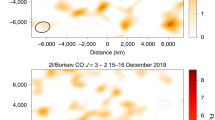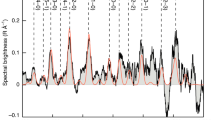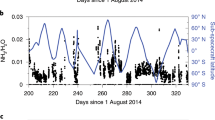Abstract
The discovery of hydrogen isocyanide (HNC) in comet Hyakutake with an abundance (relative to hydrogen cyanide, HCN) similar to that seen in dense interstellar clouds raised the possibility that these molecules might be surviving interstellar material1. The preservation of material from the Sun's parent molecular cloud would provide important constraints on the processes that took place in the protostellar nebula. But another possibility is that HNC is produced by photochemical processes in the coma, which means that its abundance could not be used as a direct constraint on conditions in the early Solar System. Here we show that the HNC/HCN ratio determined for comet Hale–Bopp varied with heliocentric distance in a way that matches the predictions of models of gas-phase chemical production of HNC in the coma, but cannot be explained if the HNC molecules were coming from the comet's nucleus. We conclude that HNC forms mainly by chemical reactions in the coma, and that such reactions need to be considered when attempting to deduce the composition of the nucleus from observations of the coma.
This is a preview of subscription content, access via your institution
Access options
Subscribe to this journal
Receive 51 print issues and online access
$199.00 per year
only $3.90 per issue
Buy this article
- Purchase on Springer Link
- Instant access to full article PDF
Prices may be subject to local taxes which are calculated during checkout



Similar content being viewed by others
References
Irvine, W. M.et al. Spectroscopic evidence for interstellar ices in comet Hyakutake. Nature 383, 418–420 (1996).
Lovas, F. J. Recommended rest frequencies for observed interstellar molecular microwave transitions — 1991 revision. J. Phys. Chem. Ref. Data 21, 181–271 (1992).
Bockele'e-Morvan, D., Padman, R., Davies, J. K. & Crovisier, J. Observations of submillimeter lines of CH3OH, HCN, and H2CO in comet P/Swift-Tuttle with the James Clerk Maxwell Telescope. Planet. Space Sci. 42, 655–662 (1994).
Lovell, A. J. et al. HCO+ imaging of comet C/1995 O1 Hale-Bopp. Astrophys. J. Lett. 497, L117–L121 (1998).
Wink, J.et al. Evidence for extended sources and temporal modulations in molecular observations of C/1995 O1 (Hale-Bopp) at the IRAM interferometer. Earth Moon PlanetsAbstr. (in the press).
Biver, N.et al. Evolution of the outgassing of Comet Hale-Bopp (C/1995 O1) from radio observations. Science 275, 1915–1918 (1997).
Biver, N.et al. Long-term evolution of the outgassing of comet Hale-Bopp from radio observations. Earth Moon Planets(in the press).
Irvine, W. M.et al. in The Far Infrared and Submillimetre Universe (ed. Wilson, A.) 277–280 (SP-401, ESA, Noordwijk Netherlands, (1997).
Notesco, G. & Bar-Nun, A. Trapping of methanol, hydrogen cyanide, and n-hexane in water ice, above its transformation temperature to the crystalline form. Icarus 126, 336–341 (1997).
Tacconi-Garman, L. E., Schloerb, F. P. & Claussen, M. J. High spectral resolution observations and kinematic modeling of the 1667 MHz hyperfine transition of OH in comets Halley (1982i), Giacobini-Zinner (1984e), Hartley-Good (1985l), Thiele (1985m), and Wilson (1986l). Astrophys. J. 364, 672–686 (1990).
Lovell, A. J.et al. HCO+ ion-molecule chemistry in comet C/1995 O1 Hale-Bopp. Earth Moon Planets(in the press).
Bergin, E. A. & Langer, W. D. Chemical evolution in pre-protostellar and protostellar cores. Astrophys. J. 486, 316–328 (1997).
Irvine, W. H.et al. Chemistry in cometary comae. Faraday Discuss. 109(in the press).
Herbst, E. What are the products of polyatomic ion-electron dissociative recombination reactions? Astrophys. J. 222, 508–516 (1978).
Shiba, Y., Hirano, T., Nagashima, U. & Ishii, K. Potential energy surfaces and branching ratio of the dissociative recombination reaction HCNH+ + e−: An ab initio molecular orbital study. J. Chem. Phys. 108, 698–705 (1998).
Hirota, T., Yamamoto, S., Mikami, H. & Ohishi, M. Abundances of HCN and HNC in dark cloud cores. Astrophys. J.(in the press).
Mumma, M. J., Weissman, P. R. & Stern, S. A. in Protostars and Planets III (eds Levy, E. H. & Lunine, J. I.) 1177–1252 (Univ. Arizona Press, Tucson, (1993).
Fomenkova, M. in From Stardust to Planetesimals (eds Pendleton, Y. J. & Tielens, A. G. G. M.) 415–421 (ASP Conf. Ser.122, Astron. Soc. Pacific, San Francisco, (1997).
Rodgers, S. D. & Chamley, S. B. HNC and HCN in comets. Astrophys. J. Lett.(in the press).
Crovisier, J. Rotational and vibrational synthetic spectra of linear parent molecules in comets. Astron. Astrophys. Suppl. 68, 223–258 (1987).
Festou, M. C., Rickman, H. & West, R. M. Comets II. Models, evolution, origin and outlook. Astron. Astrophys. Rev. 5, 37–163 (1993).
Goldsmith, P. F., Langer, W. D., Ellder, J., Irvine, W. M. & Kollberg, E. Determination of the HNC to HCN abundance ratio in giant molecular clouds. Astrophys. J. 249, 524–531 (1981).
Goldsmith, P. F., Irvine, W. M., Hjalmarson, & & Å & Ellder, J. Variations in the HCN/HNC abundance ratio in the Orion moelcular cloud. Astrophys. J. 310, 383–391 (1986).
Olofsson, H., Johansson, L. E. B., Hjalmarson, & & Å. & Nguyen-Quang-Rieu High sensitivity molecular line observations of IRC +10216. Astron. Astrophys. 107, & 128–144 (1982).
Schmidt, H. U., Wegman, R., Huebner, W. F. & Boice, D. C. Cometary gas and plasma flow with detailed chemistry. Comput. Phys. Commun. 49, 17–59 (1988).
Proc. 1st Int. Conf. on Comet Hale-Bopp (to be published as a special issue of Earth, Moon, Planets).
Acknowledgements
We thank B. Marsden and D. Tholen for rapidly providing us with the best available cometary elements, and the staff at the JCMT for their assistance with the observations. This work was partly supported by the NSF and NASA.
Author information
Authors and Affiliations
Corresponding author
Rights and permissions
About this article
Cite this article
Irvine, W., Bergin, E., Dickens, J. et al. Chemical processing in the coma as the source of cometary HNC. Nature 393, 547–550 (1998). https://doi.org/10.1038/31171
Received:
Accepted:
Issue Date:
DOI: https://doi.org/10.1038/31171
This article is cited by
-
The tautomerization of H2NCH2C(OH)NH to H2NCH2CONH2 in the interstellar medium
Science China Physics, Mechanics and Astronomy (2011)
-
Distributed Sources in Comets
Space Science Reviews (2008)
Comments
By submitting a comment you agree to abide by our Terms and Community Guidelines. If you find something abusive or that does not comply with our terms or guidelines please flag it as inappropriate.



